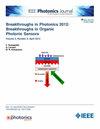基于无DAC强度调制器的w波段矢量毫米波信号生成
IF 2.1
4区 工程技术
Q3 ENGINEERING, ELECTRICAL & ELECTRONIC
引用次数: 0
摘要
我们提出并通过实验证明了一种基于强度调制器、无需数模转换器(DAC)即可生成自适应 N2-QAM W 波段矢量毫米波(mm-wave)信号的新方法。通过使用两个马赫-泽恩德(Mach-Zehnder)调制器、并联移相器、衰减器和单个光混频器,将两个 N 振幅移调(N-ASK)信号合成为 N2-QAM W 波段毫米波矢量信号。在这种方案中,发射器省略了 DAC 和额外的数字信号处理,用户端可获得双倍比特率。以 N = 2 的情况为例,我们最终使用 2-ASK 信号生成了 80-GHz 4-QAM W 波段毫米波,并在 1 米长的无线链路上完成了高性能传输。测得的误码率(BER)性能低于 7% 的硬判定前向纠错(HD-FEC)阈值 3.8 × 10-3。本文章由计算机程序翻译,如有差异,请以英文原文为准。
W-Band Vector Millimeter Wave Signal Generation Based on Intensity Modulators Without DAC
We proposed and experimentally demonstrated a novel method to generate an adaptive
N
2
-quadrature amplitude modulation (
N
2
-QAM) W-band vector millimeter wave (mm-wave) signal based on intensity modulators without digital to analog converter (DAC). Two N-amplitude shift keying (N-ASK) signals are synthesized into
N
2
-QAM W-band mm-wave vector signals by employing two Mach-Zehnder modulators, paralleling phase shifters, attenuators and a single optical mixer. In this scheme, DAC and additional digital signal processing are omitted at the transmitter, and double bit rate can be obtained at the user end. Taking the case of N = 2 as an example, we finally used 2-ASK signals to generate 80-GHz 4-QAM W-band mm-wave, and completed its high-performance transmission over a 1-m wireless link. The measured bit error rate (BER) performance can reach below 7% hard-decision forward-error-correction (HD-FEC) threshold of 3.8 × 10
−3
.
求助全文
通过发布文献求助,成功后即可免费获取论文全文。
去求助
来源期刊

IEEE Photonics Journal
ENGINEERING, ELECTRICAL & ELECTRONIC-OPTICS
CiteScore
4.50
自引率
8.30%
发文量
489
审稿时长
1.4 months
期刊介绍:
Breakthroughs in the generation of light and in its control and utilization have given rise to the field of Photonics, a rapidly expanding area of science and technology with major technological and economic impact. Photonics integrates quantum electronics and optics to accelerate progress in the generation of novel photon sources and in their utilization in emerging applications at the micro and nano scales spanning from the far-infrared/THz to the x-ray region of the electromagnetic spectrum. IEEE Photonics Journal is an online-only journal dedicated to the rapid disclosure of top-quality peer-reviewed research at the forefront of all areas of photonics. Contributions addressing issues ranging from fundamental understanding to emerging technologies and applications are within the scope of the Journal. The Journal includes topics in: Photon sources from far infrared to X-rays, Photonics materials and engineered photonic structures, Integrated optics and optoelectronic, Ultrafast, attosecond, high field and short wavelength photonics, Biophotonics, including DNA photonics, Nanophotonics, Magnetophotonics, Fundamentals of light propagation and interaction; nonlinear effects, Optical data storage, Fiber optics and optical communications devices, systems, and technologies, Micro Opto Electro Mechanical Systems (MOEMS), Microwave photonics, Optical Sensors.
 求助内容:
求助内容: 应助结果提醒方式:
应助结果提醒方式:


